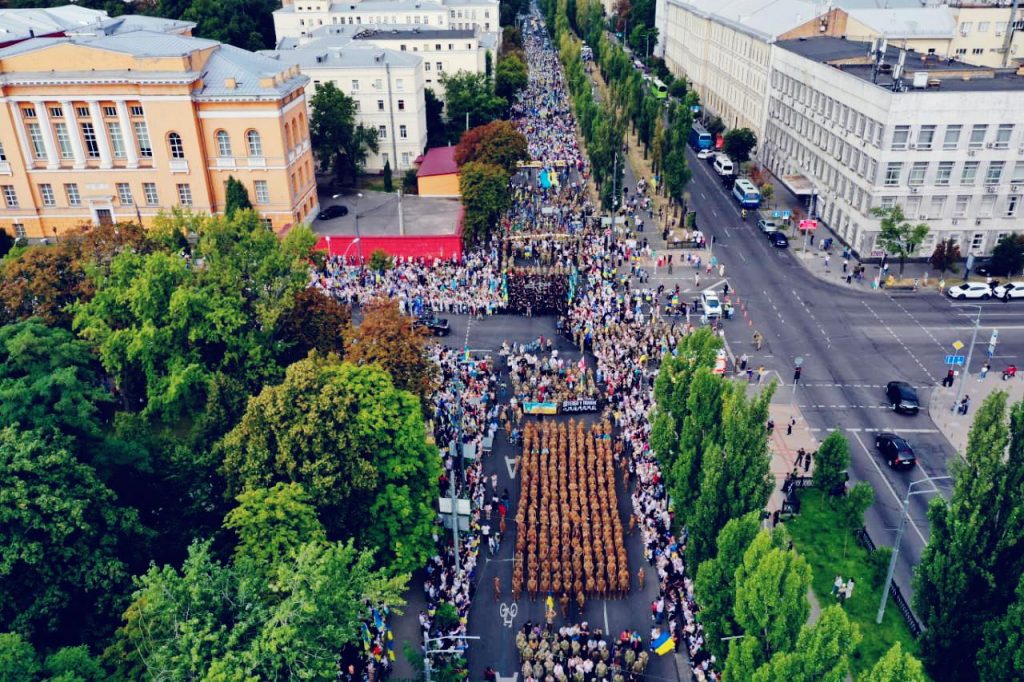President Zelenskyy took part in official celebrations on Sofiyivska Ploshcha, starting with a ceremony honoring soldiers killed in hostilities in eastern Ukraine. He explained that there was no parade not only due to the coronavirus pandemic, but also because military vehicles were better located on the frontline in Donbas, referred to the war in only in praising the ceasefire that has been holding for 29 days, and did not resist the urge to make habitual jabs at past President Petro Poroshenko.
Then, a concert followed, which came under the fire of netizens over the overly frivolous participation of controversial artists known for performances in Russia, something that has gone out of vogue in Ukraine after 2014. The official ceremony lasted only 1.5 hours.
“Last year, on Independence Day, the veteran-military community came out to a March of Defenders of Ukraine, which confidently went down in history. Not only did something indescribably beautiful happen; a tradition that fills a new Ukrainian mythology and identity was born. Power. Will. The struggle,” said the organizers of the 2020 march on its official page.
Various military, veteran, and volunteer organizations joined the organizing committee; funds were gathered through Come Back Alive, a military charity that emerged after the Euromaidan revolution to provide essentials for the ragtag army presenting an unexpected resistance to the Russian-backed militants in eastern Ukraine.
At least 48 units took part in the march. It was led by the families of the servicemen killed in Donbas and families of slain Euromaidan protesters, families of prisoners and missing persons, as well as wounded veterans of the Russian-Ukrainian war.

A separate unit was dedicated to a campaign to free three accused Donbas war participants suspected of murdering journalist Pavlo Sheremet in a case sorely lacking evidence and widely regarded as political:

Apart from veterans representing the 25 Ukrainian oblasts, including occupied Crimea, there were units from military regiments that started off as volunteer battalions, including Aidar and Azov, veterans and combat medic organizations, military volunteers, and others.
Ukrainian blue and yellow flags, the red-black Ukrainian nationalist flag, and, occasionally, the Belarusian national flag were flown. No political parties or slogans were allowed.
20,000 people took part in the march, the police informed. Similar, smaller marches in Lviv, Dnipro, Zaporizhzhia, and Kharkiv,
The format of celebrations today is a far cry from the massive military parades during the presidency of Petro Poroshenko. In 2018, the parade featured divisions from 10 NATO countries. The topic of Ukraine’s ongoing war with Russia for independence was at the forefront.
With Zelenskyy, the format changed. The incumbent president has brushed the reality of the war with Russia under the carpet. In his speech, he talked about coronavirus, national unity, returning all Ukrainian prisoners home, and that a victory parade will be in the future, “when we return all our people and all our territories, when there will be lasting peace on our land.”
Traditionally, he did not mention who is responsible for a lack of peace in Ukraine nowadays and from whom Ukraine will return its people and territories.
References to Russia as the aggressor have all but vanished from Ukrainian state lingo after Zelenskyy’s election.
The march held today in Kyiv, show that not everyone agrees with this turn.
Read more;
- Show replaces army parade on Ukraine’s 28th Independence day, so veterans hold their own march
- Units from ten NATO countries and Javelins in military parade on Ukraine’s 27th Independence Day
- Military gear adapted to NATO standards and other novelties at Ukraine’s Independence Day Parade




















































